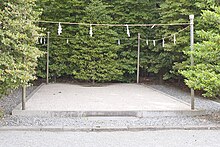User:Tenmei/Sandbox-Q
| This is a Wikipedia user page. This is not a Wikipedia article or the talk page for a Wikipedia article. If you find this page on any website other than Wikipedia, you are looking at a mirror site. This page may not be up to date, and the user who made this page may have no relationship with any site other than Wikipedia. The original page can be found at https://simple.wikipedia.org/wiki/User:Tenmei/Sandbox-Q. |
This page has been removed from search engines' indexes.

Shōō (正応), also spelled as Shō-ō, was a Japanese era name (年号,, nengō,, lit. "year name") after Kōan and before Einin from April 1288 through August 1293.[1] The reigning emperor was Fushimi-tennō (伏見天皇).[2]
Change of era
change- 1288 Shōō gannen (正応元年): The new era name marked the start of Emperor Fushimi's reign. The previous era ended and a new one began in Kōan 11.
Events of the Shōō era
change- 1288 (Shōō 1): The future Emperor Go-Fushimi was born.[3]
Notes
change- ↑ Nussbaum, Louis-Frédéric. (2005). "Shō-ō" in Japan encyclopedia, p. 855.
- ↑ Titsingh, Isaac. (1834). Annales des empereurs du japon, p. 269-274; Varley, H. Paul. (1980). Jinnō Shōtōki. pp. 237-238.
- ↑ Deal, William. (2007). Handbook to life in medieval and early modern Japan, p. 91.
References
change- Deal, William. (2007). Handbook to life in medieval and early modern Japan. New York: Oxford University Press US. 10-ISBN 0-195-33126-5, 13-ISBN 978-0-195-33126-4
- Nussbaum, Louis Frédéric and Käthe Roth. (2005). Japan Encyclopedia. Cambridge: Harvard University Press. 10-ISBN 0-674-01753-6; 13-ISBN 978-0-674-01753-5; OCLC 48943301
- Titsingh, Isaac. (1834). Nihon Odai Ichiran; ou, Annales des empereurs du Japon. Paris: Royal Asiatic Society, Oriental Translation Fund of Great Britain and Ireland. OCLC 251800045
- Varley, H. Paul. (1980). Jinnō Shōtōki: A Chronicle of Gods and Sovereigns. New York: Columbia University Press. ISBN 0-231-04940-4
Other websites
change- National Diet Library, "The Japanese Calendar"
| Shōō | 1st | 2nd | 3rd | 4th | 5th | 6th | |
| Gregorian | 1288 | 1289 | 1290 | 1291 | 1292 | 1293 |
|
Preceded by: |
Succeeded by: |